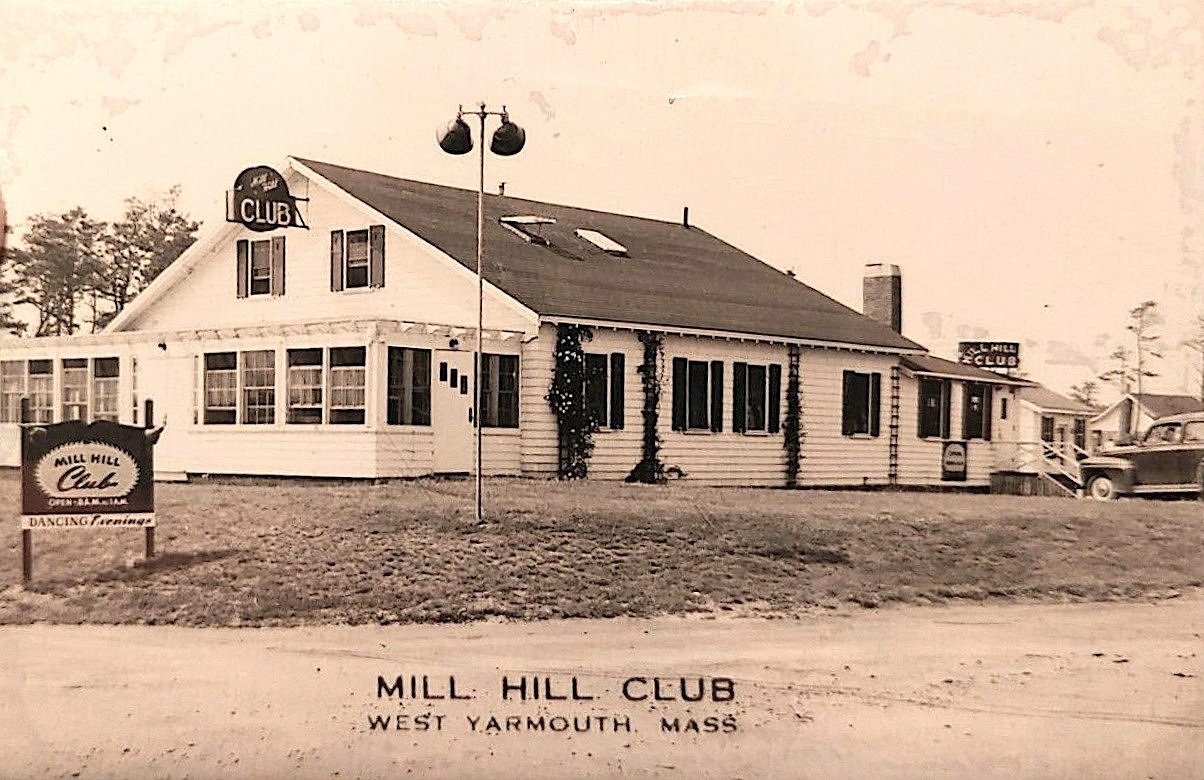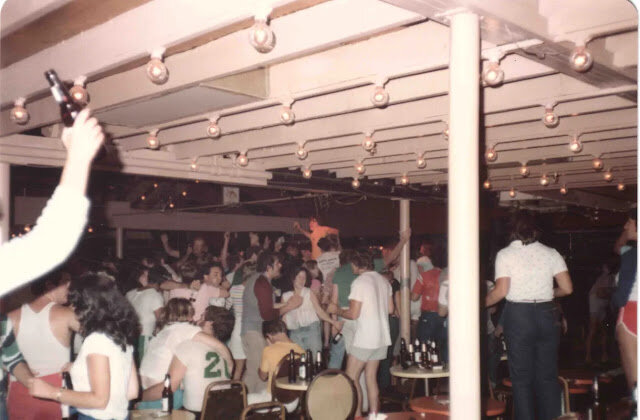The name Mill Hill surely comes from nearby Baxter Mill, built in the 18th century to grind grain, and can still be found, now restored, on Route 28. The name came to mean something entirely different in the 20th century, when both sides of Route 28 hosted the Cape’s first real entertainment complex.
The first business on Mill Hill started in 1924. Called the Old Mill Tavern, the owners built a 40 foot by 40 foot building with a 12 foot piazza which featured both great food and dancing. The owner, Mrs. Rose Klous, advertised menu items such as “chicken and waffle dinners.”
The Old Mill Tavern
A seasonal business, it opened in June and stayed open through the summer. Newell Chase’s Orchestra, boasting an “international” reputation, furnished the music. These were not easy times for this new facility, as it faced competition from the largest ballroom in the area, the Pavilion, located just across the street. Prohibition also was in full swing (1920-1933) and this was damaging to a venue with “tavern” in its name.
In November of 1928 the Pavilion burned down, and nothing replaced it for a year until Ernie Baker built his Rainbow Ballroom at the end of the summer of 1930, right next door to the Old Mill Tavern. That summer, before the Rainbow opened, the Tavern boasted that on the night before the 4th of July, dancing would take place from 10 pm to 4 am with the All Star Player Orchestra.
The Great Depression hit all businesses which catered to tourists hard. Competition from the Rainbow, along with Prohibition, added to a devastating impact on the Old Mill Tavern. While it stayed in business for a time, the property was foreclosed on in 1941. Meanwhile the Rainbow was able to draw large crowds with entertainment like Chick Webb and Ella Fitzgerald “direct from Harlem.”
1937
After World War II, the Cape experienced a boom. Affordable cars now allowed new freedom to travel, and the Route 28 area witnessed incredible growth, much of it aimed at tourists. Yarmouth ended up with the second most rooms for rent in the state, second only to Boston. It was during this time that the Mill Hill Club opened in the Old Mill Tavern building. The building was enlarged and changed several times, expanding from the original 1600 square feet of the Old Mill Tavern to more than 8500 square feet.
Mill Hill Club, early 1950s.
While its patrons still debate as to when the Mill Hill Club reached its zenith, by the 1960s, for many, weekends on the Cape weren’t complete without visiting Cape nightspots. Peter, Paul, and Mary played here in the early 60s. For three decades, happy hours at the Crystal Palace, the Mill Hill Club, the Improper Bostonian, and Pufferbellies had incredible reputations and followings. In 2010, the Boston Herald produced a movie called “History of the Cape Cod Happy Hour,” and it featured these nightspots.
One of the performers at the Mill Hill Club in 1970 was Joe Baldi of the band Boston Soul Revue. He recalled playing there for six weeks. Returning in 1977 with the band Renegade, he noted the music had become more hard rock. He remembered the “escapades at the band house behind the club were outrageous, and we enjoyed every minute. Now it’s just a piece of defunct rock history.”
Inside the former Mill Hill Club.
But the Mill Hill Club hadn’t always been all hard rock. In 2019 the Cape lost one of its truly great jazz trumpet players, Lou Colombo, who died in a car accident in Florida. Lou had played at the Mill Hill Club nearly every weekend during periods of the late 60s and early 70s. He moved his family to the Cape and also performed at a number of other venues in the area.
The entertainers at the Mill Hill Club were so good that in 1979 an LP record was released called “Live” featuring various artists performing at the Club. The record can still be found for sale on the internet for those who wish to relive those days. It includes songs by Strutt, Lewis and Clark Expedition, Roundhouse, Clutch, the Gringos, Spun Gold and DJ Sullivan - all very popular local bands -and it identified the band members in the groups.
The Mill Hill Club also reaped its share of unfavorable publicity. In August 1982, Yarmouth selectmen penalized the club for liquor violations, cutting an hour a day from its opening times. On May 18th, 1983, a fire broke out in the Mill Hill Club’s ladies room. Although serious enough to burn through to the roof, the Mill Hill Club was back in action that very night! Questions still linger as to what or who caused the fire.
The nineties heralded even more wild times at the Club. One person remembered a waitress wearing a star-spangled bikini when waiting on tables the 4th of July, and another remembered “Chippendale” type performers.
Adjectives such as loud, lively, outlandish, sleazy, and rowdy were frequently used to describe this era. Amplifiers and bands became louder and noise complaints became more frequent, causing Yarmouth selectmen to tell club owners to either solve the noise problem or close one hour earlier. Sound insulation used at that time was combustible, and we all remember the horrific Station Club fire in Rhode Island in February 2003 which killed more than 100 patrons. The Mill Hill Club had a similar type of insulation, causing the Yarmouth Fire Department to shut it down until the decorations and insulation were fireproofed.
From this point, the Mill Hill Club declined quickly. Newspaper articles discussing a proposed assisted living facility at Mill Hill noted that the Club had been virtually closed since 2005 but still had a valid occupancy permit and liquor license. That license noted that it was 8500 square feet on 1.4 acres, with parking for 150 cars. If you called the Mill Hill Club phone at that time, however, you’d get a recorded announcement stating that the Club was sometimes open Thursday and Friday. A real estate website noted that it was “formerly the Mill Hill Club.” In December 2007, the Club reported it was operating one day a week for a few hours to maintain its license. But in essence, Mill Hill Club was dying.
Demolition begins on the Mill Hill Club in 2014.
The Mill Hill area has changed greatly. The Mill Hill Club site is now an assisted living facility that features the former club’s disco ball in the front lobby. Some joke that the very people that partied at Mill Hill in the 1970s could be living there now. The Rainbow Ballroom and Rollerdrome is now a Salvation Army Thrift Store. The two room Yarmouth police station, built right behind the Rainbow in 1942, is no longer there, moved to a new facility in 1956 at the corner of Higgins Crowell Road and Route 28, and then in 2001 to a new building further down the road. Memories of famous musicians, performers, and entertainers are all that remain of the various Mill Hill area entertainment venues; the Pavilion, the Rainbow Ballroom, the Mill Hill Arena, the Old Mill Tavern, the Mill Hill Club, and the nearby Sandy Pond Club.
An aerial view of the Mill Hill area ca 1940.
Excerpted from an article researched and written by Duncan Oliver.










